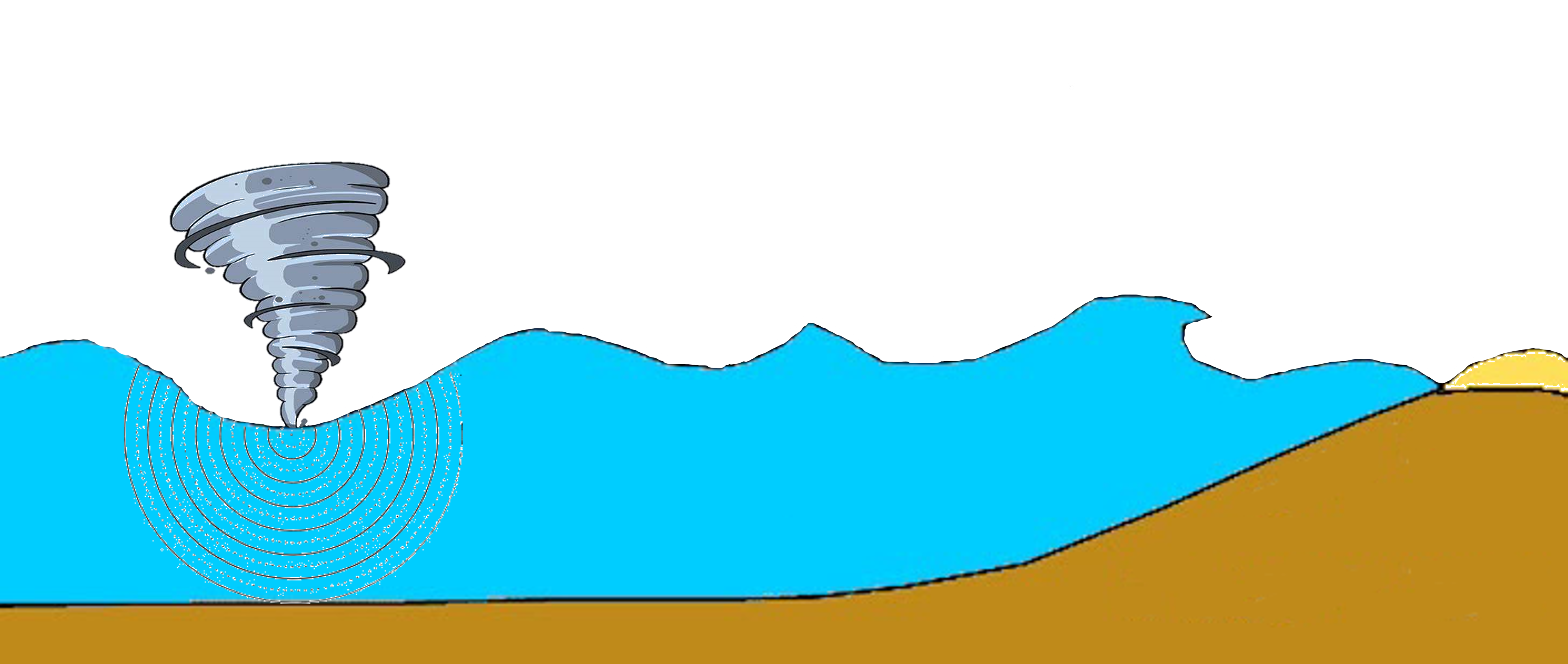Underwater Noise Caused by Weather
Underwater noise is caused by various sources such as weather conditions, seismic, human, and natural life. In extreme weather conditions such as hurricanes (or typhoons), underwater noise increases significantly. However, the increase in noise due to hurricanes is not equal to a normal wind of the same Beaufort scale. This is due to the change in the underwater sound velocity profile, the decrease in water temperature and even the warming of the seafloor sediment because of hurricane [1]. Apart from wind, rain and snowfall also influence underwater noise. According to [2] it is clearly seen that the noise floor increases between 300-9600 Hz as the amount of precipitation increases. Also in [3], the noise caused by the bubbles created because of the raindrops hits the water surface is modeled, depending on the size of the raindrop, the impact energy, and the amount of plunge. In parallel [4] stated that there is a relationship between the size of rain drops and noise. In addition, the measurements made as a result of this study shows that the noise caused by the wind contains higher frequency components compared to the noise caused by weather events such as rain and hail. Modeling the noise increase caused by weather conditions can be beneficial for the accurate detection of noise levels and its effects during a process (for example, pile driving), improving SONAR performance, and accurately detecting the noise generated by marine animals/mammals [5].

Low frequency signals can travel very long distances in various environments. Therefore, various studies have been carried out to model noise sources with low frequency (< 300 Hz) components such as wind noise in deep sea studies [1, 2, 6]. With the development of successful noise models, studies have been carried out on the reverse solution which aims the estimating the wind speed or precipitation amount from the noise record [7, 8, 9].
There are several successful approaches to modeling the noise produced by hurricanes in modeling different frequencies and states. In [1], these approaches are stated as Wilson approach, Kuperman-Ferla approach and Kewley approach. While Wilson provides better modeling at low wind speed and frequency bands (< 1000 Hz), the Kuperman-Ferla approach performs good modeling at higher frequencies (400-3200 Hz) and shallow waters. The Kewley approach, on the other hand, expresses the noise floor as a function of the cube of the wind speed in recordings taken with a vertically placed recorder array.
In the study [1], the underwater noise generated by the hurricane was modeled with the reverse approach, using the formula based on Harrison's ray theory. In this approach, each hydrophone is considered as a noise source and various points on the water surface are considered as recording devices. During the simulations, the signals are randomly scaled, and phase differences added to obtain a noise close to the real noise. As a result, the noise floor found as,
\begin{equation} NSL_{m}=log_{10}C+p log_{10}f+nlog_{10}v \end{equation}
where v wind speed, f frequency, C, p and n are coefficients.
In summary, the noise generated by extreme weather conditions differs from the normal wind, rain or hail but the studies show that even these extreme conditions can be modeled to adjust precision of SONAR applications or improve scientific researches.
- [1] Q. Yang, K. Yang, and S. Duan, “A Method for Noise Source Levels Inversion with Underwater Ambient Noise Generated by Typhoon in Deep Ocean,” Journal of Theoretical and Computational Acoustics, vol. 26, no. 02, p. 1850007, 2018.
- [2] N. Bom, “Effect of Rain on Underwater Noise Level,” The Journal of the Acoustical Society of America, vol. 45, no. 1, pp. 150–156, 1969.
- [3] H. N. Oguz and A. N. Prosperetti, “Numerical calculation of the underwater noise of rain,” Journal of Fluid Mechanics Digital Archive, vol. 228, p. 417, 1991.
- [4] J. A. Scrimger, D. J. Evans, G. A. Mcbean, D. M. Farmer, and B. R. Kerman, “Underwater noise due to rain, hail, and snow,” The Journal of the Acoustical Society of America, vol. 81, no. 1, pp. 79–86, 1987.
- [5] B. B. Ma, J. A. Nystuen, and R.-C. Lien, “Prediction of underwater sound levels from rain and wind,” The Journal of the Acoustical Society of America, vol. 117, no. 6, pp. 3555–3565, 2005.
- [6] N. R. Chapman and J. W. Cornish, “Wind dependence of deep ocean ambient noise at low frequencies,” The Journal of the Acoustical Society of America, vol. 93, no. 2, pp. 782–789, 1993.
- [7] S. Pensieri, R. Bozzano, J. A. Nystuen, E. N. Anagnostou, M. N. Anagnostou, and R. Bechini, “Underwater Acoustic Measurements to Estimate Wind and Rainfall in the Mediterranean Sea,” Advances in Meteorology, vol. 2015, pp. 1–18, 2015.
- [8] P. Shaw, D. Watts, and H. Rossby, “On the estimation of oceanic wind speed and stress from ambient noise measurements,” Deep Sea Research, vol. 25, no. 12, pp. 1225–1233, 1978.
- [9] J. D. Wilson and N. C. Makris, “Ocean acoustic hurricane classification,” The Journal of the Acoustical Society of America, vol. 119, no. 1, pp. 168–181, 2006.